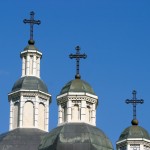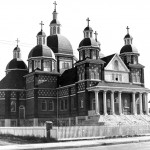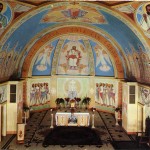Built partly by parishioners and volunteers during the dark days of World War II, St. Josaphat Ukranian Catholic Cathedral is one of the finest examples of Canadian-Ukrainian church architecture. The cathedral, on 18 city lots at 10825 97th Street, combines elements of Roman, American Colonial and Renaissance styling. It was the first building constructed in what came to be known as Prairie Cathedral style.
With seven domes, an entry portico with eight Tuscan columns, two-toned red brick veneer with inlaid cream-coloured crosses, and intricate religious paintings, St. Josaphat is a showcase of Byzantine influences. In recognition of its historical and architectural importance, it was designed a Provincial Historic Resource in 1983 and just this year was named a Municipal Historic Resource by the City of Edmonton.
Plans for the building were announced in 1938 by Rev. Sozont Stephan Dydyk, the leader of the Ukrainian Basilian Fathers, who came to Edmonton in 1902 and built a wooden church on the site in 1904. The blessing for that first church was on November 27, 1904 – the feast of St. Josaphat.
The little church served the community for the next 35 years but as the congregation outgrew it, the need for a replacement became evident. With Canada still in the grips of the Great Depression and murmurs of war in the wind, the church nonetheless forged ahead with an ambitious plan.
To design it, Rev. Dydyk commissioned Phillip Ruh, an Oblate priest who had studied architecture in Germany and served in Ukraine. His plans for St. Josaphat found inspiration in traditional Ukrainian church architecture while inventing the Prairie Cathedral style.
In keeping with Byzantine tradition, the building was erected in the form of a cross with seven octagonal copper cupolas, each topped with a cross. They symbolize the Seven Sacraments and the Seven Gifts of the Holy Spirit.
The interior is divided into three main parts: vestibule (entrance), nave (main body), and sanctuary (the altar area). Just the largest dome is open to the interior. Ruh originally envisioned a taller church, but the site was on a flight path for the Edmonton Municipal Airport, and so the height was reduced to a 100 foot maximum.
In all, Ruh designed more than 30 churches throughout Western Canada and Ontario, but this ranks as the pinnacle of his achievements. “St. Josaphat is the most grandiose example of Ruh’s work in Alberta, expressing the architect’s rich sense of historical continuity with the Byzantine tradition and his appreciation for Ukrainian Baroque ideals,” states an Alberta Culture historical assessment.
Construction began in October 1939 with excavation of the footings and the basement dug by parishioners. The war slowed progress, and the project was completed in 1947 at a total cost of about $250,000 (although contribution of thousands of hours of volunteer time reduced the cash outlay to about $150,000).
The church was dedicated on June 3, 1947, and declared a cathedral the following year when Edmonton was selected as the seat of a new exarchate (administrative district), headed by Bishop Neil N. Savaryn. The 1904 church, adjacent to the cathedral, was demolished.
Professor Julian Bucmaniuk was hired in 1950 and brought from Europe to decorate the expansive interior with Byzantine iconography. Bucmaniuk was a renowned muralist who had painted the Basilian Parish church in Zhovkva, Ukraine before the war. He and his son Bohdan began the commission in 1951, using tempera (powdered pigments, eggs, milk, linseed oil and carbonic acid) to adorn the walls and ceilings with richly coloured murals and frescoes. Their work took five years.
The Baroque-style paintings portray major events in the life of Christ, the Mother of God, Apostles and the Saints. Bucmaniuk used parishioners as models for the saints and a young priest as a model for Christ. The dominant colours are blue for heaven and serenity, and yellow for brightness and tranquillity.
“The whole of the church participates in the Eastern Christian vision of sacred space,” notes the Alberta Culture report. “From the seven cupolas representing the sacraments and the gifts of the Holy Spirit to the interior iconography expressing the sanctification of human experience through the presence of the Divine.”
In 1967, Bucmaniuk began work on an iconostas but was only able to complete the icon of the Mother of God in the lower corner before his death. Parascevia Ivanec, a former student of Bucmaniuk’s, painted five icons on the lower portions and the small icons on the royal and deacon’s doors. Ivan L. Denysenko, an American artist, painted the icons in the upper portion and completed the iconostas.
The cathedral had been open just 36 years when it was declared a provincial historical resource in August 1983, making it one of the youngest buildings to be so designated in Alberta. Time and soot generated from burning candles had taken their toll on the interior, and local artist Wasyl Burak was hired to delicately clean the surfaces using benzene and bread. Burak became ill and died, and the cleaning was completed in 1985 by Don Hucul.
Other remedial work has included laying of a new floor in 1989 and replacement of the roof in 1990. The original front steps were removed and new ones constructed in 2005.
Under this spring’s Municipal Historic Resource designation, the City of Edmonton has agreed to provide up to $500,000 to restore the exterior finish, windows, roof and framing. Analysis shows the building requires $1.6 million in restoration work, most of it to be paid by the owners, the Ukrainian Catholic Episcopal Corporation of Western Canada.
The work will help ensure the continued service of one of the McCauley neighbourhood’s most beloved landmark buildings.





